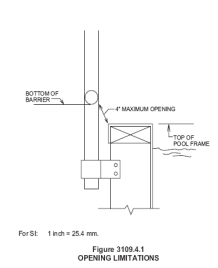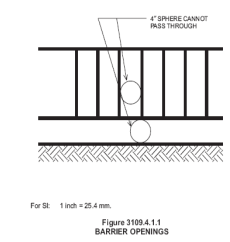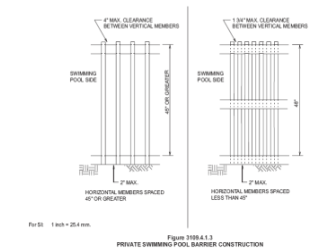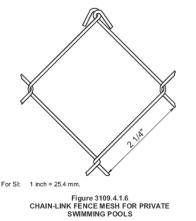Deck FAQs
What is the height requirement for a deck to have railing?
A. Porches, balconies, ramps or raised floor surfaces located more than 30 inches above the floor or grade below shall have guards not less than 36 inches in height.
Open sides of stairs with a total rise of more than 30 inches above the floor or grade below shall have guards not less than 34 inches in height measured vertically from the nosing of the treads.
Porches and decks which are enclosed with insect screening shall be equipped with guards where the walking surface is located more than 30 inches above the floor or grade below. As per NYS – 2010 Residential code - R312.1 Guards.
Barrier protection for POOLS over 24”
An outdoor residential swimming pool must be provided with a barrier which completely surrounds the swimming pool and obstructs access to the swimming pool. The barrier may consist of a fence, a wall, a building wall, or any combination thereof. The barrier must be at least 4 feet (48 inches) high, and must satisfy certain specified requirements (which are discussed in more detail below).
Access gates must satisfy the requirements applicable to barriers, as well as certain additional requirements (which are discussed in more detail below). In addition, access gates must be securely locked with a key, combination or other child-proof lock sufficient to prevent access to the swimming pool through such gate when the swimming pool is not in use or supervised.
Note: In general, the barrier requirements discussed in this document apply to all swimming pools, without regard to the date of construction or installation of the pool.
Note: As mentioned above, the definition of “swimming pool” includes hot tubs and spas. However, a hot tub or spa with a safety cover that complies with reference standard ASTM F 1346, entitled Standard Performance Specification for Safety Covers and Labeling Requirements for All Covers for Swimming Pools, Spas and Hot Tubs, is exempt from the barrier requirements discussed here.
The principal purpose of the NYS Uniform Code’s barrier requirements is to make swimming pools inaccessible to young children. The specific requirements discussed below are intended to prevent a child from crawling under the barrier, fitting through the barrier, or climbing over the barrier. The requirements for access gates are intended to prevent a child from opening an access gate.
Barriers provided for outdoor residential swimming pools must satisfy the following requirements:
- The barrier must completely surround the swimming pool and must obstruct access to the swimming pool.
- The barrier must be at least 4 feet (48 inches) high.
- The space between the bottom of the barrier and the ground cannot exceed 2 inches.
- In the case of an above-ground pool, the barrier may be at ground level or mounted on top of the pool structure; however, if the barrier is mounted on top of the pool structure, the space between the top of the pool structure and the bottom of the barrier cannot exceed 4 inches. See Figure 3109.4.1 on Page 3.
- Any opening in the barrier must be small enough to prevent the passage of a 4-inch-diameter sphere through the opening. See Figure 3109.4.1.1


- A barrier that does not have openings, such as a masonry or stone wall, cannot contain indentations or protrusions (except for normal construction tolerances and tooled masonry joints).
- Where the barrier is composed of horizontal and vertical members and the distance between the tops of the horizontal members is less than 45 inches:
- the horizontal members must be located on the swimming pool side of the fence;
- the spacing between vertical members cannot exceed 1.75 inches; and
- the spacing within any decorative cutouts in vertical members cannot exceed 1.75 inches. See Figure 3109.4.1.3 below.


The figures on this page appear with the permission of the International Code Council. These figures may not be reproduced without the express written consent of the International Code Council.
- Where the barrier is composed of horizontal and vertical members and the distance between the tops of the horizontal members is 45 inches or more:
- the spacing between vertical members cannot exceed 4 inches; and
- the spacing within any decorative cutouts in vertical members cannot exceed 1.75 inches. See Figure 3109.4.1.3 below.
- If a chain link fence is used as the barrier, the mesh size cannot exceed 2.25-inch square unless the fence is provided with slats fastened at the top or the bottom which reduce the openings to not more than 1.75 inches. See Figure 3109.4.1.6 above.
- Where the barrier is composed of diagonal members, such as a lattice fence, the opening formed by the diagonal members cannot exceed 1.75 inches.
- Access gates must satisfy the requirements stated above, and with the following additional requirements:
- All gates must be self-closing.
- In addition, if the gate is a pedestrian access gate, the gate must open outward, away from the pool.
- All gates shall be self-latching, with the latch handle located within the enclosure (i.e, on the pool side of the enclosure) and at least 40 inches (1016 mm) above grade.
- In addition, if the latch handle is located less than 54 inches (1372 mm) from the bottom of the gate, the latch handle shall be located at least 3 inches (76 mm) below the top of the gate, and neither the gate nor the barrier shall have any opening greater than 0.5 inch (12.7 mm) within 18 inches (457 mm) of the latch handle.
- All gates shall be securely locked with a key, combination or other child proof lock sufficient to prevent access to the swimming pool through such gate when the swimming pool is not in use or supervised.
- All gates must be self-closing.
- A building wall can form part of the required barrier. However, where a wall of a dwelling serves as part of the barrier, at least one of the following requirements must be satisfied:
- the pool must be equipped with a powered safety cover in compliance with reference standard ASTM F1346, entitled Standard Performance Specification for Safety Covers and Labeling Requirements for All Covers for Swimming Pools, Spas and Hot Tubs; or
- all doors with direct access to the pool through that wall must be equipped with an alarm which:
- produces an audible warning when the door and its screen, if present, are opened,
- sounds continuously for a minimum of 30 seconds immediately after the door is opened,
- is capable of being heard throughout the house during normal household activities,
- automatically resets under all conditions, and
- is equipped with a manual means, such as touchpad or switch, to deactivate the alarm temporarily for a single opening (such deactivation cannot last for more than 15 seconds, and the deactivation switch[es] must be located at least 54 inches above the threshold of the door); or
- other means of protection, such as self-closing doors with self-latching devices, which are approved by the governing body and which afford a degree of protection not less than the protection afforded by the powered safety cover and door alarm described above, must be provided.
- In the case of an above-ground pool, the pool structure itself can serve as a part of the required barrier, provided that the pool structure is sufficiently rigid to obstruct access to the pool. However, where an above-ground pool structure is used as a barrier or where the barrier is mounted on top of the pool structure, and the means of access is a ladder or steps, then:
- the ladder or steps shall be capable of being secured, locked or removed to prevent access, or the ladder or steps shall be surrounded by a complying swimming pool barrier ;
- when the ladder or steps are secured, locked or removed, any opening created shall not allow the passage of a 4-inch-diameter sphere.
- Barriers shall be located so as to prohibit permanent structures, equipment or similar objects from being used to climb the barriers.

